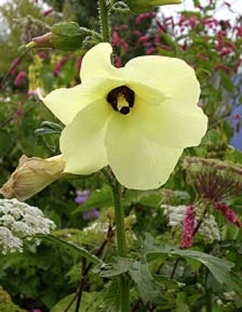Article from the
Tropical Plant Society of Denver
by Paula Szilard
Edible Hibiscus
(Abelmoschus manihot)
In
Honolulu in the community gardens where I once had a vegetable plot,
many gardeners including me grew edible hibiscus plants with pale
yellow flowers and dark red/brown centers—attractive but not
approaching the stunning beauty of the ornamental hibiscuses we all
know. Originally from south or southeast Asia, edible
hibiscus, or Abelmoschus
manihot is widely used in the islands of the Pacific,
particularly in the Melanesian archipelago (New Guinea, Solomon
Islands, Fiji, Vanuatu and New Caledonia). Researchers think
that it was probably first cultivated there because so many distinct
varieties are found in this area. This plant goes by literally dozens
of names in many Pacific island languages. It is commonly
known as Aibika and Bele in Micronesia.
This plant was placed into the genus Hibiscus, the
subsection Abelmoschus
by Linnaeus, but in 1787 a botanist named Medikus proposed that this
group of plants be made a separate genus and it’s been so ever
since. It was introduced into Europe around 1712 from India
and is listed in an American seed catalog dated
1806. The leaves of the many varieties are highly
variable. Some are heart shaped, some spear shaped, and some
are palmate with 3, 5 or 7-lobed similar to the maple leaf, but often
more deeply cut.
 |
The parts of the plant that are eaten are the
young leaves and shoots, which are cooked, baked or stir fried and
which exude a gelatinous substance similar to okra. In fact,
this plant is in the same genus as okra, Abelmoschus esculentus. In the Pacific, a favorite preparation method is to cook it in coconut
milk. In Hawaii, my favorite way to prepare edible hibiscus
was to stir fry it in Asian sesame oil in a wok, with a couple of
cloves of pressed garlic. After they were cooked tender, I added a
small amount of low-sodium soy sauce and a very small amount of water.
It was delicious, but you have to enjoy the mucilaginous texture.
In the ground in warm climates (Zones 8-10), it
is a perennial growing to 6 ft or taller. In mild temperate climates
with some winter frosts, it dies back to the ground and grows back from
the underground parts.
Abelmoschus
manihot thrives in full sun to part shade and well drained
garden loam. It does not do well in highly alkaline soils,
however. In cold climates like ours you can plant it in your
garden as an annual, or better yet, grow it in a large pot to customize
soil and control size. Fertilize with a nitrogen-rich
fertilizer for larger leaves and better yields. Although
these plants have the usual complement of diseases and pests, they
don’t seem to be bothered by them so far from their natural habitat.
Edible hibiscus is a nutrition
powerhouse. When compared to cold climate greens such as
cooked spinach, cooked edible hibiscus has much more of everything
that’s good for us. It’s got twice as much protein as
spinach, not insignificant in parts of the world where protein sources
are scarce or expensive, nearly twice the vitamin A, more fiber and
nearly as much vitamin C as a small banana (when cooked, mind
you!) It contains over twice the amount of riboflavin, nearly
twice the thiamine and a lot more of several of the minerals, including
iron, potassium and calcium. Convinced yet?
There are important traditional medicinal uses
as well. Westerners may scoff, but native peoples of
Micronesia use it to cure colds, sore throats, dysentery, diarrhea and
skin rashes. They also use it to control fertility, to induce
abortions, and paradoxically, to ease childbirth. It is said
pregnant women don’t use it to avoid aborting. Modern medicine has not been idle, though. Researchers have
found antiviral activity in extracts from this plant, discovered it
reduces bone loss in rats, and have established that an ethanol extract
of the plant has anticonvulsant and antidepressant properties.
This plant can be propagated from seed, or from
stem cuttings, which can be rooted in water if this is changed daily
and is kept in a shady spot. When planting the cuttings, bury
2-6 of the nodes for extra bushiness. Rooting hormone is
generally unnecessary, but allow the stems to callus over for about 24
hours. People who don’t want to go to this much trouble may
be able to find plants on line.
I purchased my seeds from the Thomas Jefferson
Center for Historic Plants at Monticello. They have a very
hard seed coat, which must be filed or knicked to allow moisture to
penetrate for quicker germination. If you don’t do this, it
could take months for the seeds to germinate. I took a fine
pruning shears and cautiously snipped into one end of the seed with the
tip. I planted the seeds in April and they germinated in a
little over a week.
I put one in a large pot and a second one in
the ground in my front edible landscape. Two months later,
the potted one is about 1 1/2 ft tall and is starting to flower, while
the one planted out into the garden is much smaller. Soon I
hope to be cooking up the greens!
Sources :
Toensmeier, Eric. Perennial
Vegetables. White River Junction, VY: Chelsea Green
Publishing, 2007.
Preston, Stephen R. et al. Aibika/Bele. Abelmoschus manihot (L) Medik. Rome,
Italy: International Plant Genetic Resource Institute,
1998. (Promoting the Conservation and Use of Underutilized
and Neglected Crops No. 24) Full text found on:
www.biodiversityinternational.org.
Back to
Sunset
hibiscus Page
|
|
